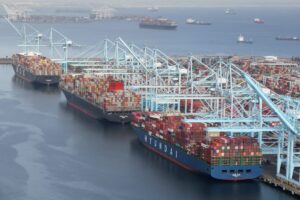Fitch Ratings is calling for another solid year for container shipping industry earnings as port congestion will continue to prevent a return to pre-pandemic levels. For shippers, this means high shipping costs and supply chain challenges are here to stay, at least in the near-term.

The container shipping industry earned a “mind-bending” $59 billion in profits in the first quarter of 2022—a new record—as the industry to benefit from stronger pricing.
Container shipping company profits are likely to have another very strong year in 2022 as freight rates remain high despite moderate easing these last three months, the credit ratings agency said in a global container shipping update issued Monday.
High freight rates along with buoyant demand have led to an increase in the fleet orderbook, which is about 26% of the existing fleet, compared to less than 10% at the beginning of the pandemic, Fitch said. However, the industry could be headed for a turning point in 2023, when growth in vessel capacity is likely to exceed container demand.
“The capacity deployment discipline during the peak periods of pandemic-related lockdowns in 2020 was partly the result of industry-wide consolidation in the previous decade, as it reduced the need to gain market share. However, whether this discipline holds with the arrival of new fleet remains to be seen. Some of the excess cash from the ongoing bumper profits has gone to debt reduction, but increased capex, shareholder returns and bolt-on acquisitions have been the other uses across the industry,” Fitch said.
Read Also: US President Biden Signs The Ocean Shipping Reform Act Into Law
Fitch sees acquisitions as a result container shipping companies’ push to become door-to-door logistics providers as being good for the longer-term growth and stability of the industry.
While China’s COVID lockdowns have helped to ease port congestion, lingering congestion in key markets in the United States and North Europe will continue to keep freight rates high and prevent a return to normalcy, at least in the near-term.
“Most of the freight rate increases over the last two years were driven by increase in port congestion as a result of pandemic-related operational bottlenecks and higher demand due to consumer spending shifts to non-perishable goods and away from services. Port congestion remains an issue in both the US and European ports. Chinese lockdowns, although leading to lower container volumes for February-April 2022, have not been sufficient to ease the congestion.
“Union issues at ports and the arrival of peak season for container volumes means congestion issues are unlikely to be resolved in the near term. If port congestion continues into 2023, it could partly absorb the new vessel capacity due to be delivered in 2023,” Fitch’s update said.
Kindly like us on Facebook















